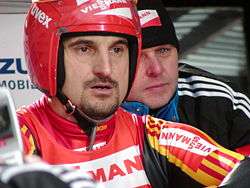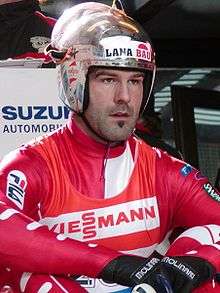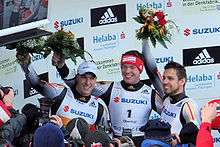Luge
|
Departing German luger at the 2010 Olympics | |
| Highest governing body | Fédération Internationale de Luge de Course |
|---|---|
| First played | 1870s |
| Characteristics | |
| Contact | No |
| Team members | Teams of 1 or 2 |
| Mixed gender | Yes, but usually in separate competitions |
| Type | Winter sport, Time trial |
| Equipment | Sled, helmet, suit, visor, gloves, finger spikes, booties |
| Venue | Luge tracks |
| Presence | |
| Olympic | Part of Winter Olympic program in 1964 to today |
A luge /ˈluːʒ/ is a small one- or two-person sled on which one sleds supine (face up) and feet-first. Steering is done by flexing the sled's runners with the calf of each leg or exerting opposite shoulder pressure to the seat. Racing sleds weigh 21–25 kilograms (46–55 lb) for singles and 25–30 kilograms (55–66 lb) for doubles.[1] Luge is also the name of an Olympic sport. Lugers can reach speeds of 140 km per hour (87 mph). Manuel Pfister of Austria, reached a top speed of 154 km per hour (95.69 mph) on the track in Whistler, Canada prior to the 2010 Winter Olympics.[2] Lugers compete against a timer and on artificial tracks are timed to a thousandth of a second, making luge one of the most precisely timed sports in the world. The first recorded use of the term "luge" is 1905, from the Savoy/Swiss dialect of French "luge" meaning "small coasting sled", and is possibly from a Gaulish word with the same root as English sled.[3][4]
History


The practical use of sleds is ancient and widespread. The first recorded sled races took place in Norway sometime during the 15th century.[5]]]
The sport of luge, like the skeleton and the bobsleigh, originated in the health-spa town of St Moritz, Switzerland, in the mid-to-late 19th century, through the endeavours of hotel entrepreneur Caspar Badrutt.Badrutt successfully sold the idea of winter resorting, as well as rooms with food, drink, and activities. His more adventurous English guests began adapting delivery boys' sleds for recreation, which led to collisions with pedestrians as they sped down the lanes and alleys of the village.
The first organized meeting of the sport took place in 1883 in Switzerland.[6] In 1913, the Internationale Schlittensportverband or International Sled Sports Federation was founded in Dresden, Germany. This body governed the sport until 1935, when it was incorporated in the Fédération Internationale de Bobsleigh et de Tobogganing (FIBT, International Bobsleigh and Tobogganing Federation). After it had been decided that luge would replace the sport of skeleton at the Olympic Games, the first World Championships in the sport were held in 1955 in Oslo (Norway). In 1957, the Fédération Internationale de Luge de Course (FIL, International Luge Federation) was founded. Luge events were first included in the Olympic Winter Games in 1964.
Americans were slow to adopt the sport of luge. The first luge run in North America was built at Lolo Hot Springs, Montana in 1965.[7][8] Although the United States competed in every Olympic luge event from 1964 through 1976, it was not until 1979 that the United States Luge Association was founded. The first artificial American track was completed in that year for use in the 1980 XIII Winter Olympic Games at Lake Placid, New York.[5] Since that time the United States luge program has greatly improved. A second artificial track was constructed near Park City, Utah for the 2002 XIX Olympic Winter Games at Salt Lake City.
Artificial tracks



Artificial luge tracks have specially-designed and -constructed banked curves plus walled-in straights. Most tracks are artificially refrigerated, but artificial tracks without artificial cooling also exist (for example, in St. Moritz). Tracks tend to be very smooth.[4]
The athletes ride in a flat, aerodynamic position on the sled, keeping their heads low to minimize air resistance. They steer the sled mainly with their calves by applying pressure on the runners—right calf to turn left, left calf to turn right. It takes a precise mix of shifting body weight, applying pressure with calves and rolling the shoulders. There are also handles for minor adjustments. A successful luger maintains complete concentration and relaxation on the sled while traveling at high speeds. Most lugers "visualize" the course in their minds before sliding. Fastest times result from following the perfect "line" down the track. Any slight error, such as a brush of the wall, costs time. Track conditions are also important. Softer ice tends to slow speeds, while harder ice tends to lead to faster times. Lugers race at speeds averaging 120–145 km/h (75–90 mph) around high banked curves while experiencing a centripetal acceleration of up to 5g. Men's Singles have their start locations near where the bobsled and skeleton competitors start at most tracks, while both the Doubles and Women's Singles competition have their starthouse located further down the track. Artificial track luge is the fastest and most agile sledding sport.[4]
Natural track luge
Natural tracks are adapted from existing mountain roads and paths. Artificially banked curves are not permitted.[9] The track's surface should be horizontal. They are naturally iced. Tracks can get rough from the braking and steering action. Athletes use a steering rein and drag their hands and use their legs in order to drive around the tight flat corners. Braking is often required in front of curves and is accomplished by the use of spikes built on the bottom of the shoes.[4]
Most of the tracks are situated in Austria and Italy, with others in Germany, Poland, Russia, Slovenia, Canada, Switzerland, Croatia, Liechtenstein, Turkia, Sweden, Finland, Norway, Bulgaria, Romania, New Zealand and the United States. The Upper Peninsula Luge Club[10] in Negaunee, Michigan, is home to one of only five lighted natural track luge runs in the world, and the only natural track in the United States.[11] The over 800 meter (half-mile) track features 29 curves along its 88-meter (289 ft) vertical drop. The club hosts international luge events and offers luge instruction to the public during the winter months.[4]
World championships have been held since 1979 while European championships have been held since 1970.
Events
There are four luge disciplines.
- Men's singles
- Doubles (mixed event)
- Women's singles
- Team Relay (Olympic discipline starting in 2014)
These are further broken into several age classes - multiple youth and junior classes that cover the range of age 7–20, and general class (ages 21 and older).[1] Older competitors may enjoy the sport in masters (age 30–50), and senior masters (age 51+) classes.[12] In a team relay competition one man, one woman and a doubles pair form a team. A touchpad at the bottom of the run is touched by a competitor signaling a teammate at the top of the run to start.[4]
Rules and procedures for races are very precise:
- A drawing is held to determine start order for the race. Athletes are assigned a number which is displayed on a bib. During major national and international events, Men's singles consists of four runs. Women's singles and doubles competitions consist of two runs. The cumulative time of all runs is used to determine finish order. In all three events, the start order after the first run is determined by the outcome of the previous run, with the last-place slider sliding first, the next-to-last place slider sliding second, and so forth, with the leader of the previous run sliding last.[4]
- Physical measurements of the sled are taken, and the temperature of the sled's steel blades is checked and may not be more than 5 °C above that of a previously established control temperature. Additionally, for artificial track races the athlete must first be weighed. This is to determine if the athlete is entitled to carry extra weight on their body while sliding. Men may use additional weight amounting to 75% of the difference between body weight and a base weight of 90 kg. Women may use additional weight amounting to 50% of the difference between body weight and a base weight of 70 kg. Doubles athletes may use additional weight amounting to 50% of the difference between body weight and a base weight of 90 kg. Additional weight is not allowed if the body weight of the front person and back person together exceeds 180 kg.[4] If one of the partners weighs more than 90 kg, the weight exceeding the 90 kg mark is added to the lighter partner. If there should still be a difference between the partner’s weight and the 90 kg mark, the difference can be compensated according to an official weight table.[1] Between runs athletes are randomly selected for additional weight checks. Before each run the sled (with the athlete, for artificial track races) is weighed at the start ramp.
- Once an athlete is on their sled they are audibly notified that the track is clear. At this point a tone sounds and the athlete has thirty seconds to begin their run. A run becomes official when an athlete and their sled, in contact with one another, crosses the finish line. If an athlete and sled are not within contact of one another the athlete is disqualified from further competition. Disqualifications may also take place for any violation of rules and regulations. Certain disqualifications may be appealed.[1][4]
Training
The sport of luge requires an athlete to balance mental and physical fitness. To become an elite luger, a competitor must begin training at an early age and spend decades honing their skills. Physically, a luger must have strong neck, upper body, abdominal, and thigh muscles.[13] Strength training is essential to withstand the extreme G-forces of tight turns at high speeds. Since lugers have very little protection other than a visor and helmet, they must be able to endure the physical pounding administered by the track when mistakes are made. Mentally a luger must maintain total focus as they steer their sled through more than a kilometer of curves and straights at high speed. Dozens of subtle movements and weight shifts are required to find the perfect line down the track. Consistency is essential for success. Sled maintenance is also an important element for success. Serious lugers spend hours meticulously sanding their "steels," and making other important adjustments and repairs to their sleds. No luger can possibly achieve elite status without working closely with an experienced coaching staff, implementing suggestions and fine tuning technique. Other lugers will often give tips that can improve a slider's ability to find the "sweet spot" on the track. Though luge is a winter sport, it requires daily, year-round training.
Risks
As with many extreme sports, luging has risks. Though most injuries involve bumps, bruises, broken bones and concussions, fatalities do occasionally occur. Georgian luger Nodar Kumaritashvili suffered a fatal crash during his final practice run for the 2010 Winter Olympics in Whistler, British Columbia, Canada.[14] Hours later, the International Luge Federation concluded that the accident was caused by a steering error and not a track error; nevertheless, changes to the track were made before the re-opening.[15] Kumaritashvili was the fourth athlete to die while in preparation for a Winter Olympics competition, following speed skier Nicolas Bochatay, 27, who died while preparing for the Albertville 1992 games, British luger Kazimierz Kay-Skrzypeski and skier Ross Milne, 19, who both died in the run-up to the Innsbruck 1964 games.[13]
Governing body
The sport of luge is governed by the FIL, Fédération International de Luge de Course. The FIL is located in Berchtesgaden, Germany and includes 53 member nations.[16] It is traditionally dominated by German representatives, however.
The following persons have been president of the FIL:
- Bert Isatitsch, Austria (1957–1994)
- Josef Fendt, Germany (1994–current)
Olympic Medal table




Men's singles
Current Olympic champion: ![]()
![]() Germany (GER)
Germany (GER) ![]()
![]() Russia (RUS)
Russia (RUS) ![]()
![]() Italy (ITA)
Italy (ITA)
| Rank | Nation | Gold | Silver | Bronze | Total |
|---|---|---|---|---|---|
| 1 | | 10 | 7 | 6 | 23 |
| 2 | | 3 | 2 | 3 | 8 |
| 3 | | 1 | 2 | 6 | 5 |
| 4 | | 0 | 3 | 2 | 5 |
| 5 | | 0 | 0 | 1 | 1 |
| Total | 14 | 14 | 14 | 42 | |
Doubles
Current Olympic champion: ![]()
![]() Germany (GER)
Germany (GER) ![]()
![]() Austria (AUT)
Austria (AUT) ![]()
![]() Latvia (LAT)
Latvia (LAT)
| Rank | Nation | Gold | Silver | Bronze | Total |
|---|---|---|---|---|---|
| 1 | | 10 | 4 | 6 | 20 |
| 2 | | 3 | 3 | 2 | 8 |
| 3 | | 2 | 2 | 3 | 7 |
| 4 | | 0 | 2 | 2 | 4 |
| 5 | | 0 | 1 | 1 | 2 |
| 6 | | 0 | 1 | 0 | 1 |
| Total | 15 | 13 | 14 | 42 | |
Women's singles
Current Olympic champion: ![]()
![]() Germany (GER)
Germany (GER) ![]()
![]() Germany (GER)
Germany (GER) ![]()
![]() United States (USA)
United States (USA)
| Rank | Nation | Gold | Silver | Bronze | Total |
|---|---|---|---|---|---|
| 1 | | 10 | 12 | 9 | 31 |
| 2 | | 2 | 0 | 0 | 2 |
| 3 | | 1 | 2 | 3 | 6 |
| 4 | | 1 | 0 | 1 | 2 |
| 5 | | 0 | 0 | 1 | 1 |
| Total | 14 | 14 | 14 | 42 | |
Team relay
Current Olympic champion: ![]()
![]() Germany (GER)
Germany (GER) ![]()
![]() Russia (RUS)
Russia (RUS) ![]()
![]() Latvia (LAT)
Latvia (LAT)
| Rank | Nation | Gold | Silver | Bronze | Total |
|---|---|---|---|---|---|
| 1 | | 1 | 0 | 0 | 1 |
| 2 | | 0 | 1 | 0 | 1 |
| 3 | | 0 | 0 | 1 | 1 |
| Total | 1 | 1 | 1 | 3 | |
Total Olympic Ranking (2014)
| Rank | Nation | Gold | Silver | Bronze | Total |
|---|---|---|---|---|---|
| 1 | | 31 | 23 | 21 | 75 |
| 2 | | 7 | 4 | 6 | 17 |
| 3 | | 5 | 7 | 7 | 19 |
| 4 | | 1 | 5 | 3 | 9 |
| 5 | | 0 | 2 | 3 | 5 |
| 6 | | 0 | 1 | 3 | 4 |
| Total | 44 | 42 | 43 | 129 | |
Fatal accidents
| Competitor | Year | Track | Section | Race | Event | Vehicle |
|---|---|---|---|---|---|---|
| |
1964 | |
Training run | 1964 Winter Olympics | Luge | |
| |
1969 | |
First run | FIL World Luge Championships 1969 | Luge | |
| |
2010 | |
Training run | 2010 Winter Olympics | Luge | |
| 1992 | Albertville | Training run | 1992 Winter Olympics | Luge | ||
| 1964 | Innsbruck | Practice run | 1964 Winter Olympics | Luge |
See also
- World Luge Championships
- World Luge Natural Track Championships
- List of Luge World Cup champions
- European Luge Championships
- European Luge Natural Track Championships
- Bobsleigh
- Skeleton
- Toboggan
- Street luge
References
- 1 2 3 4 Rules of Artificial Track Luge
- ↑ "Whistler's fast luge track poised risky". News.xinhuanet.com. 2010-02-13. Retrieved 2011-11-25.
- ↑ "Online Etymology Dictionary". Etymonline.com. Retrieved 2011-11-25.
- 1 2 3 4 5 6 7 8 9 "Luge, extreme sport disciplines".
- 1 2 "United States Luge Association". Usaluge.org. Retrieved 2011-11-25.
- ↑ "International Luge Federation". Fil-luge.org. Retrieved 2011-11-25.
- ↑ Delta Sky Mag: 124. January 2011. Missing or empty
|title=(help) - ↑ Briggeman, Kim (2014-02-06). "Lolo Hot Springs was home to first, 'pretty crude' American luge run". Missoulian. Retrieved 2014-02-07.
- ↑ "Rules of Natural Track Luge" (PDF). FIL.
- ↑ "The Upper Peninsula Luge Club". Retrieved 2015-03-03.
- ↑ "Negaunee Luge Hill Open for Public Use". The North Wind. 2009-03-12. Retrieved 2015-03-03.
- ↑ "United States Luge Association". usaluge.org. Retrieved 2015-03-03.
- 1 2 "Rules to play Luge".
- ↑ Footage of the accident
- ↑ "Joint VANOC/FIL statement". Vancouver2010.com. Retrieved 2011-11-25.
- ↑ "Member Countries – International Luge Federation". Fil-luge.org. Retrieved 2011-11-25.
- ↑ including East Germany and West Germany
- ↑ including Soviet Union
External links
| Wikimedia Commons has media related to Luge. |
- International Luge Federation
- Bob- und Schlittenverband für Deutschland/German Luge Federation
- Österreichischer Rodelverband/Austrian Luge Federation
- United States Luge Association
- Natural Track: Upper Peninsula Luge Club of Michigan, USA
- Brazilian Luge Federation
- British Luge Association
- Croatian Luge Federation
- POV Lake Placid Olympic track on YouTube
- POV Utah Olympic track on YouTube
- POV Whistler Olympic track on YouTube
- POV Oberhof track on YouTube
- POV Calgary Olympic track on YouTube
- POV Altenberg track on YouTube
- Mark Grimmette describes doubles luge on YouTube
